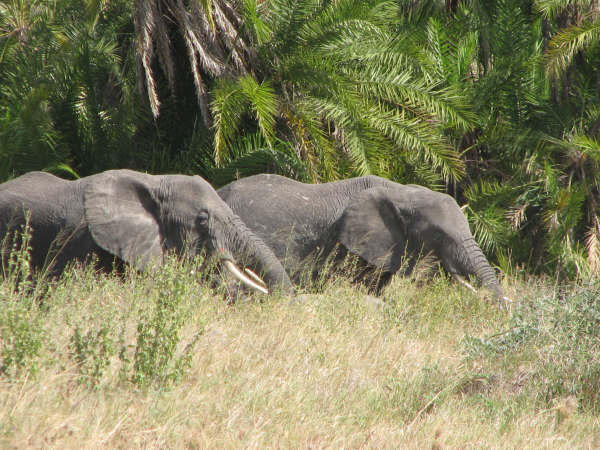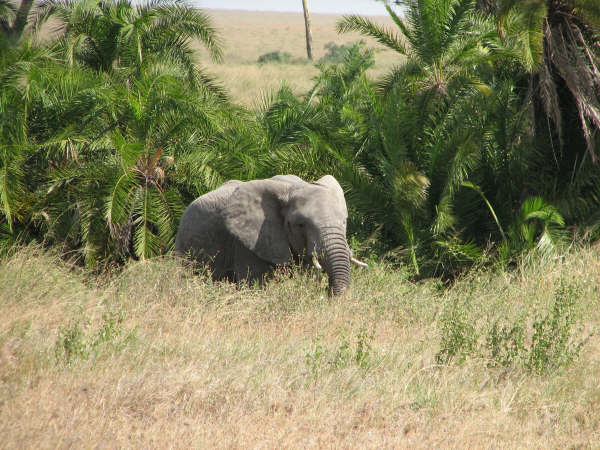ORDER:
Proboscidea
FAMILY: Elephantidae
GENUS: Loxodonta
SPECIES: africana
- I.
DESCRIPTION:
-
The
adult male is much larger than the adult female. Head and body
length including trunk: 19-24 feet. Shoulder height: 10-13 feet.
Weight: 5.5 - 7 tons. Tail: 4 feet. Brownish gray skin has folds and
may be one inch thick in places. The African Elephant has a marked
dip between its fore and hindquarters giving a concave curvature to
its back. Ears are large and fan-like. The trunk has two prehensile
protrusions at the tip. Large tusks are present in both sexes.
Elephants are digitigrade with pads of fibrous tissue to cushion toe
bones.
- II.
GEOGRAPHICAL RANGE AND HABITAT:
-
Natural
home range is 500 miles; migratory patterns are taught from one
generation to the next. Now they are mostly restricted to parks and
preserves. Habitat formerly was area south of the Sahara;
agricultural expansion has severely reduced it. Highly adaptable,
elephants can survive in forest, bush or savannah.
- III. DIET:
-
Elephants
have an inefficient digestive system and digest only about 40 per
cent of what they eat. They eat enormously. Estimates in the wild
range from 100-1000 pounds of vegetation per day (a 16 hour period).
Zoo elephants are estimated to eat approximately 50 pounds of food
per ton of elephant per day. Working elephants need 300 to 600
pounds of food per day. The wild elephant is a destructive eater,
uprooting and scattering as much as is eaten, often breaking down
whole trees. Elephants eat almost anything green, but green grass,
shoots and buds of trees and shrubs are preferred. Farms are often
raided for fruits and vegetables of all types. Average daily
consumption of water for full-grown animals is between 30 and 50
gallons.
- IV. LIFE
CYCLE/SOCIAL STRUCTURE:
-
Elephants
live in a complex matriarchal society normally composed of 8 to 15
related members and led by a dominant cow. Three or four generations
of cows and calves spend their entire lives together with the
exception of males, who leave the group at puberty. Groups of
related families stay in fairly close range of each other and
communicate often; these are called “kin groups”. In times of
danger, kin groups will mass and form “clans” of 200 or more.
Ongoing studies at Amboseli Research Center in Kenya indicate a
complex bull dominance structure which determines mating success as
well as every day life. Another primary mating factor is “musth”,
a periodic hormonal cycle seen in both species. Physical
manifestations in males include heavy secretions from temporal
glands, high blood testosterone levels, urine dribbling (marking)
and aggression. Cows seem to prefer a musth bull, but can
successfully breed whether the bull is in musth or not. According to
keepers our cows’ oestrus cycles are roughly 15-16 week ones and
last 3 days. Gestation is approximately 22 months. The birth is
usually a single one; twins are born only 1.35% of the time. Birth
weight is 175 to 250 pounds. The mother is often assisted by another
cow during birthing. The calf can stand shakily and nurse (with
mouth, not trunk) a few hours after birth. Mammary glands are
located between the front legs. Calves will nurse well into their
third year and are very dependent on their mothers for eight to ten
years. Adolescence occurs at 12 to 14 years of age. Most physical
growth is reached at 20, but growth continues throughout life. Top
mental ability is at age 30 to 45. Death comes at 65 to 70 years of
age when the last set of teeth wear out.
- V. SPECIAL
ADAPTATIONS:
-
The
majority of the skull is honeycombed with sinuses to minimize
weight. Tusks are elongated second upper incisors and grow
throughout the lifetime. They are used for food gathering and
carrying, as well as weapons. Molars make up other dental equipment;
six consecutive sets of two upper and two lower molars are produced
throughout life. The first set has three enamel layers, increasing
to ten layers in the sixth set. The trunk is an elongation of the
nose and upper lip; in adults it contains 150,000 muscles. It is
used for eating, drinking, dust and water bathing, as well as
communication. The sense of smell is highly sophisticated; they are
believed to locate underground water by smelling the earth above.
Vision is poor. Long lashes and nictitating lids protect the eyes
from dust. Hearing is acute. Recent studies establish the use of
infrasound (tones lower than humans can hear) for long-range
communication. Ears are also used to control body temperature; blood
circulating through the large vessels in the ears is cooled by
flapping.
- VI.
INTERPRETIVE INFORMATION:
-
Skin
is extremely sensitive to sunburn and insect bites; they roll in
dust and mud and throw dust on their backs to help protect their
skin. Elephants have the largest brain size versus body weight other
than man. New intelligence data: most mammals, excluding primates,
are born with a brain weight of 90% of adult weight. A human brain
at birth is 26% of adult weight, and the elephant’s is 35% of
adult weight. These statistics are used to distinguish instinctive
from learned behavior, and are examples of higher intelligence.
- VII.
STATUS IN WILD:
-
Endangered
because of loss of habitat and because of poaching for ivory. They
are listed on Appendix II of CITES (threatened), as Endangered by
the IUCN and Threatened by the USFW.
|



